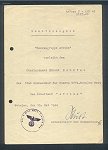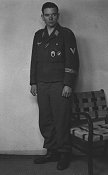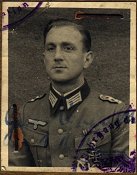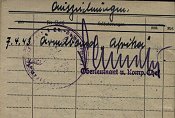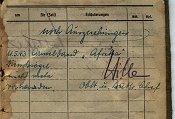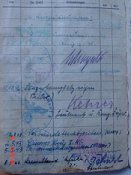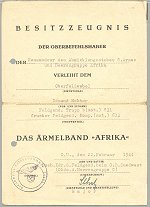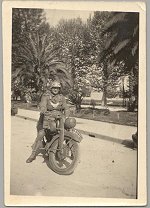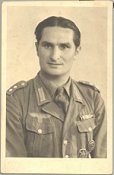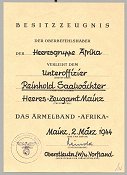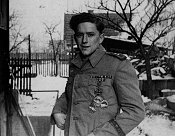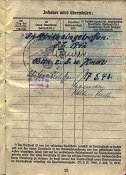
by COL Scott Pritchett
AWARD DOCUMENTS
The award of the AFRIKA cuffband was accompanied by an award document, or "Besitzzeugnis". In some cases, such as prisoners of war, this is all that was received. A portion of these latter cases were actually received through Red Cross mail while the recipient was in a POW camp in either the US, Canada or England. Like most award documents, the document for the AFRIKA cuffband was issued in a variety of formats. However, while none are easily available today for collectors, at least four styles will be encountered. These range in style from the plain text message format - the most scarce of the three - written on half sheets of paper, regulation formatted but completely unit typed, to the more formal, preprinted documents, with or without the image of a palm tree - the former being the most desirable and the latter being the most common version.
| Konvolute/grouping of an AFRIKA cuffband and telegram notification to a Gefreiter Josef Durcheck, a former member of Panzergrenadier Regiment 104 of the 21st Panzer Division sent on 14.1.44 to who must have been his next of kin, Herrn Michael Durcheck. | |
| Photo of the recipient and completely typed AFRIKA award document rendered to an Oberleutnant Edmund Schaefer. Schaefer began his career as an enlisted soldier in Schutzen Regiment 115 of the 15th Panzer Division, which later went on to become one of the two panzer divisions to comprise the famed Deutsches Afrika Korps (DAK). The document is typed in 'regulation format'. This practice was not uncommon, especially towards the end of the war or during periods when units were in action and supplies of preprinted documents were not easily obtained. All service's regulations (in this case it would have been the "Heeresmitteilungen") were published, compiled and annually updated in a record book. These record books of regulations would have been present in most all units. When a new award was entered in to the regulations, a basic format for the wording of an award document was included. It was from these formats that clerks found the correct reference for hand-typing award documents. |
The entries made on the document could be either type written or hand written, with typing being the more common method. In all cases, the award document, at a minimum, announced the command in whose name the award was being rendered, the name of the recipient, his rank, the date of authorization/awarding and the signature and title of the authorizing officer. The ranks of the officers that signed (including facsimilie signing) AFRIKA award documents varied from Feldmarschall to Konteradmiral to Hauptmann and included both commanders, acting commanders and staff officers (most usually the adjutant if a staff officer). In most cases, the award document also included some reference as to the location from which the award was given. Since the vast majority of these awards were made after the surrender in North Africa, these locations are typically within Germany or other battlefronts.
It is important for the document collector to acquire reference materials on order of battle. This helps validate some of the information recorded on the document. Many of these references will also have "by name" information on commanders and staffs that assist in verifying the probability a particular officer would be signing the document. For Heer units, Roger James Bender's and Richard D. Laws' 1973 publication, Uniforms, Organization and History of the AFRIKAKORPS is, in my opinion, by far the best source for determining what units served in North Africa. Similar resources on the Luftwaffe and Kriegsmarine are more problematic, although there are some long out of publication books on either that one can find from time to time. However, information on the Fallshirmjäger units that made up the Ramcke Brigade, which fought in North Africa from late 1942 until the surrender in 1943 can be found in several books, for example Hitler's Sky Warriors by Christopher Ailsby. They can be listed most here, as they were not numerous. The units included: Bataillon Koch (1st, 2nd Parachute Regt.), Bataillon Huebner (2nd Bataillon, 5th Para Regt.), Bataillon Burckhardt (demonstration battalion), Bataillon Von der Heydt, an artillery battalion formed from the 2nd Bataillon of the 7th Flieger Division artillery regiment) and anti tank, signals, and pioneer companies. Additionally, following the Allied invasion, from November 1942 to December 1942, 1000 replacements per day arrived in North Africa. These included the 1st and 3rd Bataillon , 5th Para Regiment, the 11th Fallshirmjäger Pioneer Battailon, Brandenburgers, and the Barenthin Parachute Regiment.
| Oberjäger Klaus Schuberth of Fallshirmjäger Regiment 12 "Sturm Regiment" which was formed from elements of I/Luftlande Sturm regiment which was part of the 4th Fallshirmjäger Division. Date of award of the Afrika band is unknown. |
An entry was usually made to document the awarding in both the soldier's Soldbuch and Wehrpaß books. The authorized/typical entries, and the books themselves, are discussed in more detail under the "Fakes and Reproductions" section of this article. Pictured below are typical entries.
Click on images to enlarge
Below I have described and/or pictured the most commonly seen documents for each service. These were kindly provided by Forum members and are not examples from previous publications.
Luftwaffe formal documents were DIN A5 (150mm x 210mm) size. Described from outside to inside and top to bottom - as pictured below - this version had a border in a pink-tan color. At the top, in an old German font was the word "Besitzurkunde". This is one of the few, if only military award documents I am aware of that used this word - most others being either "Besitzzeugnis" or "Verleihungs-Urkunde". Underneath, in the same font, were the words "Ich verleihe dem", meaning " I present (or award) to… ". The next two lines were provided for typing or hand writing in the recipient's rank and name. These provisions were denoted by six thin horizontal lines in the same pink-tan color that together formed a highlighted bar in which the typing or printing was to be entered. The upper set, which recorded the recipient's rank, were shorter than the lower set that contained the name. It should be noted that the majority of combat award documents will have the letters of the last name double-spaced if typed. However, the absence of such is not necessarily and indication of a fake. In the center of the document were three words, again in the old German font, with one word per line: "das Ärmelband "Afrika", the quotation marks around the word Afrika being stylized and appearing, as best as can be described, as small flags, or banners set between two vertical poles. It should be noted that these did not follow German grammatical protocol that called for the lead set of quotes to be at the bottom of the word and the trail set at the top. These three worded lines were superimposed over a palm tree centered between a two mounds (or low mountains) motif in the same pink-tan color as the other features. Underneath this portion were the preprinted provisions for where and when the award was issued (the date usually being typed in), positioned to the left, and the authorizing official's title, name and rank. As this was a Luftwaffe award, printed on these documents one finds "Der Oberbefehlshaber Süd - Keßelring - Generalfeldmarschall" preprinted on the award form. At the time, Kesselring was the commander in chief of the southern front. Lastly, underneath these and at the bottom were to the left, the typical official stamp - in this case that for "Der oberbefehlshaber Süd" surrounding the hoheitsadler or national symbol. To the right at the bottom was the printed letters "F.d. R: " meaning Fuer den Richtigheit, or in other words, someone was signing for the awarding officer, usually a junior subordinate. This was followed by the signature of the staff officer acting on behalf of the Oberbefehlashaber. Underneath was the signer's rank. Two versions exist in this regard, one with a preprinted rank and another with typed in rank. The typical signature made on these documents is that of a Major Pfeffer.
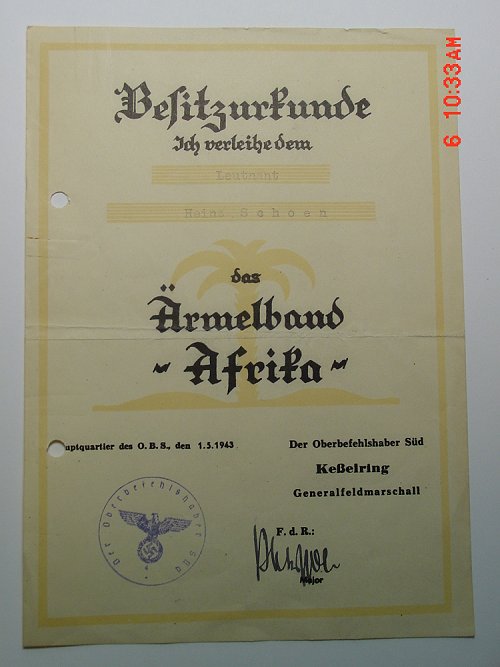
Curtis
Hall Collection
There also appears to have been a Fallshirmjäger version. It was executed in a relatively plain format. At the top, in old German text (and using upper and lower case letters) was the word "Besitzurkunde" (possession/presentation document). The use of this word is fairly unusual, as most documents carry the title 'Besitzzeugnis' (possession/presentation evidence) instead. Directly underneath is the phrase "Ich verleihe dem" (I award) followed by two blank lines - the top line for entering the recipient's rank and name, the bottom - and shorter line, for entering the recipient's unit. The words 'Armelband "Afrika"' came next under, with the quote marks around the word AFRIKA being executed on the top ends of the word rather than in accordance with German grammar that typical has the lead quote at the bottom. Toward the lower left corner are the words: "Hauptquartier des O.K.S" in a plain font, followed by a blank underline for typing in the date. The Germans used several styles to record dates. For example, the 25th of May 1943 could be written as 25. Mai 1943 or 25.5.43. Other variations are possible based on how diligent or attentive the clerk typist was. Continuing to the right toward the opposite side of the document and on line with the previous left entry were several lines of printing. The top line was "Der "Oberbefehlshaber Süd", followed underneath by "Keßelring" and under this his rank: "Generalfeldmarschall", with room for signature in between. Lastly, on the right, under Kesselring's printed signature block is the entry: "F.d.R:". The official signing for Kesselring signed with his last name under this entry. Again, the person signing many of these was this Major Pfeffer. Under his signature is printed his grade "Major" in a very small sized font. On occasion, one will find these documents signed by others with the appropriate printed (not typed) rank of the individual, for example "Leutnant I.a."
Heer formal documents were also in DIN A5 size, but were different in presentation. Besides the different format and wording, the Heer used a fill-in-the-blank reminder under each line requiring an entry to be manually put in. Starting at the top was the more commonly seen word "BESITZZEUGNIS" printed in Roman lettering, using double spaces between the letters and all caps. Next, under this were the words "DER OBERBEFEHLSHABER", again in all caps using the same font but of a smaller size. This was followed on the next line by the word "DER" and space for typing in the unit from which the recipient was assigned at the time he became authorized the award. This is usually typed in with "Heeresgruppe "AFRIKA"'. Underneath was the line, in all caps "VERLEIHT DEM" and a blank drawn line for typing in the recipient's rank. In a small size font, and enclosed parenthesis, under the blank drawn line was a reminder to the clerk preparing the document that this was the place to record the rank: the word "(Dienstgrad)". Following this, and underneath was a blank line for typing the name, that is: "(Vor und Zuname)". The next line was a similar space for recording the unit of the recipient "(Truppenteil)". Then came the title of the award: "DAS ARMELBAND >>AFRIKA<<". Some Heer examples will have typed in above this the words "mit Wirkung vom" (in effect from) and a blank space for recording the date and location of presentation manually, with the typical reminder of this style document: "(Ort Und Datum)". The locations are usually a city somewhere on the European continent/Germany proper. However, on occasion - and as was very common with many other kinds of award documents - the abbreviation O.U., for Ortsuntekunft (meaning somewhat literally 'place of the quarters' - but figuratively 'at the field headquarters, wherever that was at the time'). Toward the bottom of the document was another blank line provided for the authorizing official's signature: "(Unterschrift)", rank and duty title: "(Dienstgrad und Dienststellung)" - for service grade/rank and service position. Last, in the lower left was a doted in circle that guided the preparer in placing the unit stamp. Centered in the circle was the clerk's reminder: "(Stempel)". Pictured below is an example of an award made to an Oberfeldwebel Hektor of the Feldgendarmerie.
Kriegsmarine formal documents were also in DIN A5 size in an unadorned format. This service had its own style as well. At the top was the usual announcement line of "BESITSZEUGNIS." capitalized, with a period at the end of the word and the entire word underlined. The next line reads "Auf Grund der Ermachtigung (upper and lower case), meaning: "based on authority" or "because of the authority". Next under this is the line: "Des Oberbefehlshabers der Kriegsmarine" in upper and lower case, followed by "VERLEIHE ich dem" in all lower case except the word 'Verleihe' is capitalized. Next a dotted line was provided for typing in the rank of the recipient, and underneath was another dotted line for filling in the recipient's name - which was usually double spaced when typed. In a larger text under this is the phrase 'Das Armelband "Afrika"' which was completely underlined with two lines. The quotes around the word Afrika used the correct German grammatical construct by being alternative to one another, bottom and top/front and back of the word. The next entry was positioned to the lower left and consisted of another dotted line whose entry was noted by the preprinted words "Ort und Datum". The usual area for stamping was defined below this by marking the center of the stamp with the word "(Dienstsiegel)" in parenthesis, translated directly to mean service seal (or signet). Lastly, to the lower right was a space for entering the awarding official's signature and title. The only preprinted entry in this block of the award document was found very close to the bottom right under a doted line and reflected "Dienstgrad und Dienststellung" (service rank and service position) and "Des Verleihungsberechtigtem" meaning the individual with award granting authority, or the person having the authority to justify the award. The signature could be stamped or hand written and was the top entry in this block area of the Kriegsmarine award document. All entries were typed on up to three lines below the signature - typically: rank, title and command - and above the dotted line, with the last typed entry (usually the command from where the award was issued) being on the dotted line.
Click on images to enlarge
| Soldbuch and photo of Kriegsmarine Fahnrich (Ingenieur) Albert Eggenhoffer. Page 25 shows the entry that Eggenhoffer "arrived Africa 8.1.1942" and "left Africa 17.5.1943". He was awarded the AFRIKA cuffband on 1.4.1944 at a time when he was assigned to a Schnellbootsflotilla in the Adriatic. The photo is interesting in that he wears not only the AFRIKA band, but also 3 E-Boat badges! Aditionallly, the photo is dated in winter, yet he is wearing his Kriegsmarine tropical tunic. Eggenhoffer either had a sense of humor or no sense at all! | |
![]()
© Copyright Wehrmacht-Awards.com LLC |


